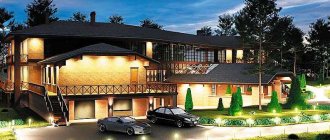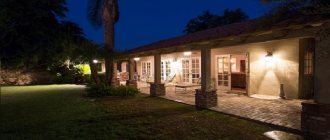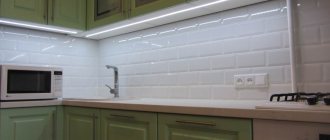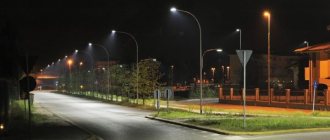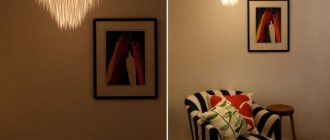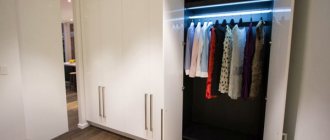In the dark, flashlights help us navigate the streets in the city. And additional illumination and color picture of the streets are created by the illuminated facades of buildings. This lighting should correspond to the style of the building and the general lighting concept in this microdistrict. Therefore, the lighting of city facades must be coordinated with the relevant services. But in this article we will only talk about lighting of country houses and private buildings.
Why do buildings need lighting?
Here everything is both simpler and more complicated. It’s simpler, because you don’t have to coordinate with anyone, but it’s more difficult, because illiterate lighting will not fulfill its functions and, therefore, a lot of money will be thrown away. What functions should façade lighting perform? Several main directions:
- Practical, that is, directly illuminating important areas - stairs, doors, paths.
- Aesthetic – creating interesting design compositions.
- Decorative – highlights elements that you would like to highlight.
In order for everything to work out in the best possible way, think through the lighting devices, their brightness and location in advance and do not neglect the advice of professionals. The purpose of outdoor lighting is:
- improve visibility on the site in the evening and at night;
- draw attention to the house and other important buildings;
- emphasize the beauty of the building and hide its shortcomings and minor flaws;
- create a favorable psychological environment.
Facade lighting makes the house and area cozy, welcoming and safe at any time of the day.
Basic rules for creating decorative lighting
Decorative lighting for a private home includes two main functions: conciseness and safety. The building immediately takes on a luxurious appearance. Additional lighting ensures safe movement in the dark.
Architectural lighting of building facades adds a certain mystery to the adjacent landscape. Thanks to her, the surrounding atmosphere acquires lightness and serenity.
You can achieve the desired effect in two ways:
Simple. It includes the action of powerful lighting spotlights, which are located in the side of the building. As you can see, the backlight is located on the surface of the earth.
The main advantage of this method is its mobility. If desired, the spotlights can be moved to another area, which will highlight individual elements of the building.
Point method. It is used to highlight certain parts of the facade. It can be used as a separate light or an overall composition.
During the creation process, it is necessary to take into account the characteristic features of lighting devices. Many lamps are not suitable for use in a private home. The fact is that each type of decorative light has a special power, which, if used incorrectly, can cause a fire.
- Photo wallpaper for the garden: which ones are suitable and how to choose
Where do they sell road curbs in Poltava (prices at the beginning of the year)
New Year's crafts from pine cones: decor ideas from pine cones for the New Year
Flood lighting is intended for high-rise buildings. It visually increases the height of the building. The use of such lighting in a country house will contribute to an uncomfortable existence for its owners.
A large number of light bulbs are located on the lower level of the building. At night, most of the residential building will be immersed in bright lighting.
Modern technologies offer a new generation of smart light bulbs. They are a design in which you can change the lighting angle. Thanks to this innovation, you will create a new type of lighting every time. This system includes flood, hidden and local types of light radiation.
Determining factors and work sequence
When developing a lighting plan, consider:
- External features of housing (color, texture, architectural style).
- Landscape of the site, location of the house on it.
- Where is the point from which the house will look best?
After this, you can start creating the project. Preliminary work consists of several stages:
- First, a general lighting concept is developed and lighting fixtures are selected.
- Electrical networks are prepared taking into account the specified lighting and brightness parameters.
- Equipment (lights, lamps, spotlights) is purchased.
The last stage is the actual installation work and launch of the lighting.
Beautiful architectural lighting or “light noise”?
Cities are illuminated more and more every year. Because of this, along with a positive effect, a negative one can also arise. It is called by many names - stray light, light pollution, light noise. But there is only one conclusion to this situation: it shouldn’t be like this.
It is necessary to avoid exposure to windows in living areas, glare and brightness. As a rule, this is a problem with old lamps. Light fluxes are distributed unevenly and in different directions.
Quote
“Analysis of light pollution is an important point in the implementation of any project. Modern LED lighting allows you to concentrate the flow in the desired plane. LEDs are durable and more energy efficient. If we take a facility in Ufa as an example: energy consumption here is about 10 kW/h, an ordinary electric kettle consumes 1-2 kW/h,” –
Rustam Guseinov Founder of Svet Expert
Rules and principles of facade lighting
To ensure that the result does not disappoint, but pleases you, follow the basic principles when installing façade lighting:
- By design, it should be as simple and reliable as possible.
- Economical energy consumption is one of the most important requirements.
- Must comply with all safety standards.
- The possibility of repairing and restoring damaged areas must also be provided for.
- It is highly desirable that the system operate automatically and be controlled from one point.
A “smart” system when organizing facade lighting is absolutely necessary so that you don’t have to run around the house and around the site looking for switches. And finally, the lamps themselves, designed to work outdoors, also have mandatory requirements, without which effective operation is impossible:
- They must have high mechanical strength. It is clear that anything is possible outside: strong wind, rain, snow - the lamp must be able to withstand these natural phenomena. It is also good if it is protected from accidental damage by an impact-resistant diffuser.
- The lamp body is rust-resistant.
- Street lamps must have a high level of dust and moisture resistance. This parameter is indicated by the letters IP and numbers. IP54 is considered optimal for street lamps.
- High heat resistance is also necessary so that on hot summer days, when exposed to direct sunlight, it continues to function.
- All elements of facade lighting must operate uninterruptedly in all weather conditions - rain, fog, snowstorm, that is, have good light output.
Stages of implementation of artistic facade lighting
First you need to make a design project. It is needed in order to be able to determine the power, number and installation locations of lamps, because without design it is not clear where on the façade we have “over-lit” and where we have “under-lit”. A lighting design project is not just a colorful drawing; first, a specialist makes lighting calculations in the program, and then creates a picture.
After the design project is ready, it is necessary to understand where the power cables will be laid and brought out to the façade to the installation sites of the lamps, what cross-section they will be and what brand they will be - for this, a technical project is developed, which also specifies the method of fastening the lamps, current loads are calculated, and a diagram lighting board, etc.
When the lighting design project and technical project are ready, lighting equipment can be purchased and installed according to their specifications. After installation and connection of the luminaires, commissioning work is carried out to achieve the best resemblance to the visualization in the design
Types of luminaires for facade lighting
- Ground - the name speaks for itself, they are sunk into the ground and serve mainly to illuminate paths and pools.
- Accent – used for local lighting. Focus attention on what you want to emphasize.
- Spot ones - perform approximately the same task as accent ones, only more concentrated.
- Linear – most often used in contour design.
- Floodlights - flood the house and area with bright light.
And their functions may be different:
- Practical - allows you to safely move around the site, illuminates stairs, doors, and paths around the house.
- Decorative – highlight an interesting detail of the house or an element of landscape design.
- Accompanying - in this case, the lighting fixtures are equipped with special sensors that respond to movement.
Errors in façade lighting
The most important mistake is that façade lighting is carried out without a design project and often turns out completely different from what was imagined. Without design and calculations, it is very easy to “overexpose” the façade or, on the contrary, install lamps with too little luminous flux and the beam will not shine through the column, pilaster, or the distance of the façade is simply needed.
The next mistake is using metal halide lamps instead of LED lamps, in addition to the fact that LED lamps are economical and durable (although they are much more expensive, but it’s worth it) - they also have a very high color rendering index, so the white color of LED and halogen lamps will be significantly differ in favor of the former. LED lamps do not require the same frequent maintenance as halogen lamps
Another mistake is the incorrect choice of color scheme for façade lighting, because... It is impossible to illuminate a historical building with columns and stucco with bright colors such as pink, red, blue, green, but exclusively with white shades - cold, warm or a competent combination of them.
Characteristic features of façade lighting
Facade lighting comes in several types:
- Flood - with the help of several spotlights, it illuminates the entire house. Its features are that it floods the building with light from the foundation to the roof, it is universal, it illuminates not only the house, but also the area around it. You can use several types of spotlights - more powerful ones create general diffused light, and smaller ones focus attention on individual details. This is a good solution if you want your home to look the same at night as it does during the day. However, for a small area, and even with dense buildings, this method is not effective and will not allow you to highlight exactly the object you want. If you choose this scenario, think about the proper placement of spotlights. For a low country house (2-3 floors), floodlights located on the ground will direct most of the light into the space, in other words, you will illuminate the night sky, which, of course, is not cost-effective. Therefore, a more correct option is to place spotlights on trees or poles. Another inconvenience is that the light of spotlights aimed at the facade will certainly illuminate the rooms. And it’s okay if it’s a living room, dining room or kitchen. What if the spotlight hits a bedroom or a nursery? This is one of the reasons why this type of lighting is rarely used in country cottages. You can illuminate a service space in this way: a summer kitchen, a cellar, or any other non-residential building.
- Local - used in suburban housing construction much more often. It focuses attention (that’s why it is also called accent) on the most functional and interesting details of the house. In this case, the roof, columns, house number and street name can be highlighted. Facade lamps are used, the light of which can be either diffused or directional. Local lighting can be organized using third-party lighting hidden on the lawn or path. The result is softer lighting. Finally, if you have not a simple country house, but a villa, then you can use both of these methods.
- Silhouette - highlights the entire house, without focusing on details. Its main task is to highlight a building against a dark background, and the light source can be hidden behind the silhouette of the house. Usually it is combined with local illumination.
- Contour - it just focuses attention on architectural details. Lamps are placed in the corners of the house, in window and door openings, along the roof. The entire building can remain in the shadow. Thanks to contour lighting, a building can look even better at night than during the day. It actively participates in festive illumination. To create contour lighting, LED strips, garlands, and multi-colored lamps are used. It is designed to highlight the spectacular features of the exterior.
- Dynamic – allows you to create entire light compositions. It is characterized by a play of colors and shades. This creates a unique artistic image of the building. This is the most effective way to hide his flaws. Modern lighting devices allow you to realize the most incredible fantasies. Thanks to the built-in computer program, the appearance of the building changes depending on weather conditions, the presence or absence of a person in it, the time of day, or simply to the beat of music. Of course, this is a very expensive and time-consuming option, but what an effect! This will be a holiday that is always with you. With the help of dynamic lighting, you can create animation on the facade of the house, you can change color compositions.
City street lighting concept
Urban lighting is not just about installing lights in poorly lit areas. This part of the work is usually included in the planning of neighborhoods and new streets, it is necessary to carry out wiring and select options that best suit the surrounding environment.
Features and rules of the organization
To ensure high-quality lighting, a number of important aspects must be taken into account. They may vary depending on external conditions and other features. But the main ones are always the same:
- It is necessary to think through the prospects for the development of the microdistrict and the emergence of new buildings. Plan at least 10 years in advance so that you don’t have to redo the lighting plan later.
- The quantity and features of already operating lighting equipment are taken into account. This can either be an addition to existing systems, either with or without modernization, or a complete replacement if it is not possible to combine new and old equipment.
- Select solutions that are suitable for performance and energy efficiency. They must comply with the current technical regulations. Technology is evolving and new options are emerging to further increase efficiency and reduce energy consumption.
- Be sure to take into account the characteristics of streets and objects located nearby. This affects both the method and location of installation, as well as the choice of power and the layout of the correct location.
- Consider the additional capabilities that lighting can perform. For example, when sidewalks are located next to the roadway, lanterns can simultaneously illuminate a road and a pedestrian area.
- Select options that provide the maximum level of security. Fault tolerance and working life are of great importance so that the lights do not have to be constantly maintained.
- A comfortable light environment should be created that fits into the overall urban concept. Very often there is already a ready-made plan that details the requirements for street lighting, which greatly simplifies the design and selection of equipment.
The design of street lighting is included in the general plan of work for the improvement of individual microdistricts.
Requirements for utilitarian street lighting
Utilitarian urban street lighting involves the use of lanterns purely for practical purposes
They should provide good visibility of the roadway, pedestrian or courtyard area and highlight particularly dangerous areas that need to be paid attention to. But we cannot lose sight of the aesthetic side, therefore the requirements for utilitarian lighting are as follows:
The graininess and reflectivity of the road surface is taken into account. This influences the choice of lantern power and the amount needed to achieve the desired effect. The arrangement of lamps is selected depending on the width of the roadway. If the road is no wider than 12 meters, it is enough to install lights on one side. In cases where the width is about 18 meters, a staggered arrangement of equipment is used. If there are several lanes and the road is no more than 32 meters in diameter, then a rectangular checkerboard pattern is used. With all options for street lighting, it is necessary to take into account the architectural and artistic appearance of the locality. This requirement is specified in paragraph 10.16 of SNiP 2-4-79. To illuminate pedestrian crossings, a lamp is placed on each side
An important point here is that the lamp should be on the right side of the pedestrian so that the driver can see him better. It is important to consider the amount of precipitation in the region and its nature. Lanterns should provide normal visibility even in the most difficult weather conditions.
An example of how the appearance of a street is transformed when a modern lighting system is installed.
Which lighting is better - warm or cold?
Color temperature is an important aspect, since urban street lighting is selected taking into account its impact on humans. You can achieve this effect:
- Cold light distorts color reproduction, but it highlights objects much more clearly in the dark and ensures visibility over a long distance. White light improves tone, helps drivers maintain concentration and not be distracted while driving. It is most suitable for highways and pedestrian crossings.
- Warm white light has a yellowish tint, which gives the streets a special coziness and tranquility. Such lanterns are suitable for creating a relaxing environment in pedestrian and park areas.
Cool lighting highlights the roadway and provides excellent visibility.
You should not place both options next to each other, as it does not look very good.
Practical nuances: preparing equipment for facade lighting
What equipment is required to fulfill dreams of beauty and round-the-clock functionality of the exterior and site? Of course, first of all it’s lighting technology:
- LED lamps or spotlights. Depending on needs, they can emit static light or change color shades.
- Gas-discharge (fluorescent) lamps.
- LED strips and garlands.
- Duralight is a flexible transparent cord with light bulbs inside.
- Flexible neon is an electroluminescent polyvinyl chloride wire with a copper core.
- Belt-light is a street garland.
Besides:
- Equipment that allows you to control on/off, intensity and direction of light fluxes.
- Equipment that provides protection and fixation of lighting fixtures.
Wonderful opportunities are provided by façade lighting built into the Smart Home system. The system controls the load, checks the state of the electrical network, and can be controlled from a remote control, tablet or smartphone. With a “light movement of your hand,” you can turn on the backlight (or it will turn on automatically at dusk), change the intensity and color palette, and set the automatic shutdown time to save energy.
Technical side of the TsUM external lighting system
Economical LED lamps were used to create architectural lighting for the central department store. The low total power of the lighting system allowed engineers to use small-section current-carrying cables. In addition, the TsUM exterior lighting system has a common power source with the interior lighting system, without causing overloads.
Protection against power surges and surges is carried out by a system of fuses and stabilizers. Automation also regulates the process of turning on/off lighting fixtures at a given time. The hardware makes it possible to integrate light-sensitive sensors into the TsUM lighting system, which initiate the process of starting or stopping the lighting equipment.
Also, the lighting devices involved in the system are protected from temperature changes and gusts of wind.
Light sources for façade lighting
- Gas discharge lamps - they can be mercury, neon, xenon, glow in different colors and generally shine quite brightly. However, the content of harmful substances makes their use and, most importantly, disposal very problematic.
- Fluorescent lamps save energy, shine brightly, last a long time, but also contain harmful substances (in particular, mercury) and are susceptible to low temperatures. Therefore, they are not very good for the street.
- LED lamps are a wonderful invention of the human mind. They consume little electricity, last a long time, can glow in different colors, and are not afraid of “neither heat nor cold.” That is why they are most often used in street lighting.
Creating a lighting scenario for architectural lighting is a task that requires creative thinking, knowledge of the features of lighting technology, because outdoors it is subject to additional stress, the ability to accurately calculate all project parameters, a good sense of style and a professional approach.
How to implement artistic lighting
It can be implemented in several ways:
- general light fill With its help you can illuminate a separate building among the total mass;
- local illumination The purpose is to highlight several architectural fragments. Please note: if there are repeating parts, their lighting will give special expressiveness;
- contour lighting It allows you to indicate the silhouette of a building using light. The building can be illuminated as a whole or in separate fragments. This way you can draw attention to columns, spiers and other elements;
- background illumination The goal is a special background of the building due to color. The backlight can be made movable and create an amazing play of light and shadows;
- various projections This refers to various images that are usually projected on the facade and can move;
- hidden lighting Designed for lighting stairs, lighting bridges, fountains;
- combined lighting Involves the use of several types of lighting at once;
- media façade is a type of façade illumination designed to change the color and intensity of the illumination. Controlled by a computer system.
Content
- What is architectural lighting?
- Main tasks and goals of façade lighting
- Lighting standards and special requirements
- Standards for architectural lighting of buildings in Nur-Sultan
- Dynamic architectural lighting
- Background architectural lighting
- Local architectural lighting
- Flood architectural lighting
- Contour architectural lighting
- Light architectural lighting
Trends and our recommendations
LEDs have the greatest prospects for development and advancement today. They are good because they have minimal brightness and average power. Such lamps can last quite a long time. LEDs work well in fairly harsh weather conditions and are able to withstand temperature changes from -40 to +40 degrees. They do not need additional time to warm up and operate normally. In addition, LEDs have a fairly large light spectrum, which varies from 2700K to 6500K, so the designer can always easily choose the most optimal lighting color tone.


